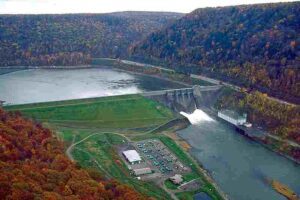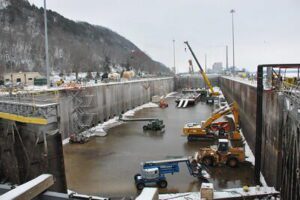5 Advantages of Hydro Energy Explained
Advantages of hydro energy are; low carbon output, scalability, hazard-control function, role in sustainable agriculture, and low-cost maintenance.
This article discusses the advantages of hydro energy, as follows;
1). Low Carbon Output (as one of the Advantages of Hydro Energy)
A low-carbon energy source refers to any energy resource or technology that emits relatively minimal amounts of carbon dioxide (CO2) when used.
Examples of low carbon energy sources are mainly renewable energy forms like solar, wind, wave, and hydro, alongside some non-renewable forms like nuclear energy [4].
Hydro energy is arguably the lowest carbon energy source when evaluated at all stages of the energy production and conversion process, including power plant construction, water flow control, and turbine operation.
This means that a hydropower plant will likely release less carbon dioxide into the atmosphere over its entire lifecycle, than a fossil fuel, geothermal, or nuclear power plant functioning at equal capacity.
Hydro energy is also lower in emission than many large-scale solar power plants, due to the materials and processes involved in the design and recycling of solar panels, among other components of such systems.
It is important to note that low-carbon attribute is often synonymous with low greenhouse emission, since carbon is a major greenhouse gas in terms of volume and effect.
Hydro energy and the production as well as use of hydroelectricity, reduce carbon emissions by excluding processes involving chemical change such as combustion; where carbon dioxide may be released as a reaction product.
The ability to utilize hydro energy with less carbon emission is beneficial to the economy, ecosystem, and human society. It also means that the risk of air pollution by hydro energy systems, alongside the health and environmental consequences of such conditions, are relatively low.
2). Scalability
The capacity of a hydropower plant in terms of electricity generation, is proportional to its water volume-capacity [1].
This means that it is possible to adjust the capacity and output of hydro energy systems to meet existing demand.
Another term which can be used to describe this is scalability; whereby a hydropower system can be designed to fit large-scale or small-scale specifications.
Large scale hydropower is used to refer to operations, mechanisms and power plants whose minimum hydro energy output is about 30 MW, while small scale hydropower plants have a maximum output of about 10 MW [7].
The difference between small scale and large scale hydropower projects is in the water storage capacity of infrastructure, size of turbines, and maximum power output.
Hydropower is economically viable because it can be scaled to meet demand, as well as due to its ability to minimize environmental degradation while being used.
3). Hazard-Control Function (as one of the Advantages of Hydro Energy)
Hydropower is both an adaptation and mitigation strategy with regards to its role in protecting the ecosystem from hazards.
Generally, the environmental impact of hydropower is low and does not extend significantly beyond the aquatic terrain.
Compared to energy from coal and other similar energy resources, hydro energy has huge potential for climate change mitigation, because it releases much less greenhouse gases than most alternatives. This helps to boost its value toward energy transition and the improvement of energy supply security [2].
Hydro energy development is also useful for mitigating the risk of hydrological hazards like flooding and stormwater pollution [6], by using water dams and other similar infrastructure to accommodate excess stormwater and control flow patterns.
To further reduce the impact of hydro energy on the environment, efficient hydropower system designs can be implemented to ensure uniform dissolved oxygen, temperature, and nutrient distribution in water, while minimizing the extent to which natural flow conditions are altered.

4). Role in Sustainable Agriculture
Hydropower contributes to sustainability by being low in carbon and pollutant emission, while producing usable energy with minimal maintenance.
Various forms of renewable energy can be used to optimize agriculture, as is observable in wind, geothermal and agrivoltaic technologies used on farms.
However, the role of hydro energy in agriculture is multidimensional.
Hydropower in agriculture refers to the use of electricity or mechanical energy from hydrological sources to power agricultural equipment and processes.
Especially in places where water resources are not scarce, this can reduce the carbon footprint of the agricultural sector by reducing the prominence of fossil fuel as a source of energy, thereby enabling agriculture to be sustainable
Aside powering equipment and reducing emissions, hydro energy development can help in sustainable irrigation of farms [9].
By encouraging water conservation, hydropower facilities also encourage soil conservation through reduced leaching and erosion risks, and more consistent supply of water to moisturize the soil. In the long run, this can help address problems like hunger and food insecurity.
5). Low-cost Maintenance (as one of the Advantages of Hydro Energy)
In comparison to other energy resources, hydro energy is relatively cheap or inexpensive to operate over the entire lifetime of a hydropower plant [3].
Since the capital cost for installing a hydropower facility is rather high, this overall low cost can be attributed directly to the maintenance of such facilities.
Hydropower systems are low-maintenance, rather than high-maintenance, because of the absence of many mechanical components, excessive heat, or fuel combustion chambers.
To maintain a hydropower system, components that should be checked include drive belts, turbines and gearboxes. Other components generally demand much less attention and low frequency of routine checkups.
The only movable part of a hydropower plant that faces significant risk of damage or degradation is the turbine [5], and such risks are only high where adequate effort has not been made to optimize other aspects of the hydropower system.

Conclusion
Advantages of hydro energy are;
1. Low Carbon Output
2. Scalability
3. Hazard-Control Function
4. Role in Sustainable Agriculture
5. Low-cost Maintenance
References
1). Ajibola, O. O. E.; Ajala, O.; Akanmu, J. O.; Balogun, O. (2018). "Improvement of hydroelectric power generation using pumped storage system." Nigerian Journal of Technology 37(1):191. Available at: https://doi.org/10.4314/njt.v37i1.25. (Accessed 18 January 2023).
2). Berga, L. (2016). "The Role of Hydropower in Climate Change Mitigation and Adaptation: A Review." Engineering 2(3):313-318. Available at: https://doi.org/10.1016/J.ENG.2016.03.004. (Accessed 16 January 2023).
3). Chala, G. T.; Ma'arof, M. I.; Sharma, R. (2019). "Trends in an increased dependence towards hydropower energy utilization-A short review." Cogent Engineering 6(1):1-14. Available at: https://doi.org/10.1080/23311916.2019.1631541. (Accessed 18 January 2023).
4). Kabeyi, J. B.; Olanrewaju, O. A. (2022). "Sustainable Energy Transition for Renewable and Low Carbon Grid Electricity Generation and Supply." Front. Energy Res., 24 March 2022. Available at: https://doi.org/10.3389/fenrg.2021.743114. (Accessed 18 January 2023).
5). Kumar, R.; Singal, S. K. (2015). "Operation and Maintenance Problems in Hydro Turbine Material in Small Hydro Power Plant." Materials Today: Proceedings 2(4-5):2323-2331. Available at: https://doi.org/10.1016/j.matpr.2015.07.284. (Accessed 16 January 2023).
6). Luu, C.; von Meding, J.; Kanjanabootra, S.; Luu, C. H. (2014). "Flood mitigation through hydropower dam management in Vietnam." Proceedings of 5th International Disaster and Risk Conference, Davos, Switzerland. Available at:
7). Rotilio, M.; Marchionni, C.; De Berardinis, P. (2017). "The Small-Scale Hydropower Plants in Sites of Environmental Value: An Italian Case Study." Sustainability 9(12):2211. Available at: https://doi.org/10.3390/su9122211. (Accessed 18 January 2023).
8). Ugwu, C.; Ozor, P.; Mbohwa, C. (2021). "Small Hydropower as a Source of Clean and Local Energy in Nigeria: Prospects and Challenges." Available at: https://doi.org/10.1016/j.jfueco.2021.100046. (Accessed 16 January 2023).
9). Zarei, S.; Bozorg-Haddad, O.; Singh, V. P.; Loáiciga, H. A. (2021). "Developing water, energy, and food sustainability performance indicators for agricultural systems." Sci Rep. 2021 Nov 24;11(1):22831. Available at: https://doi.org/10.1038/s41598-021-02147-9. (Accessed 16 January 2023).

